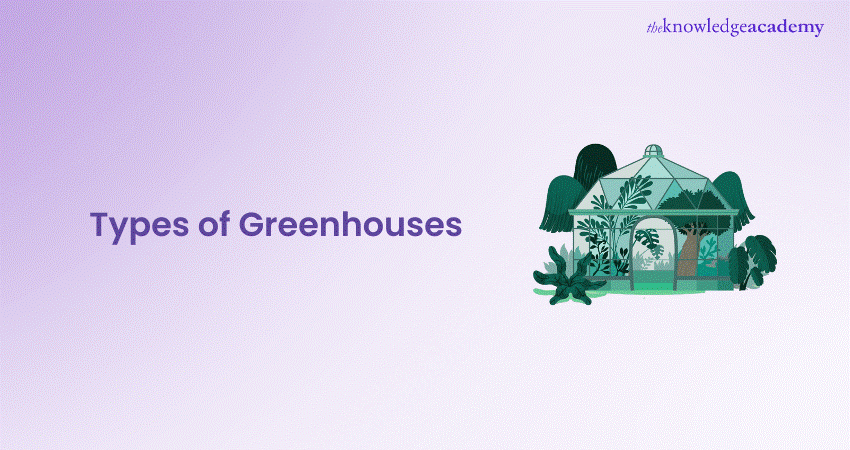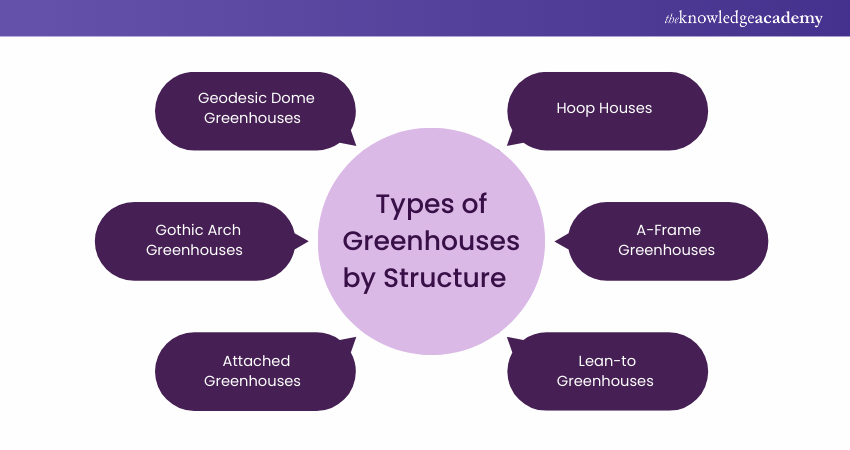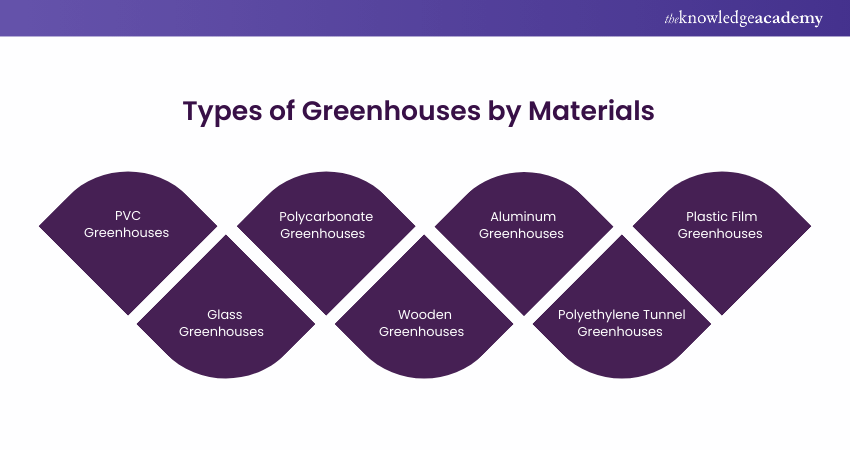We may not have the course you’re looking for. If you enquire or give us a call on 01344203999 and speak to our training experts, we may still be able to help with your training requirements.
Training Outcomes Within Your Budget!
We ensure quality, budget-alignment, and timely delivery by our expert instructors.

Ever wondered how you can grow plants throughout the year, regardless of the weather? Greenhouses are the one-stop answer to your plant-dwelling chaos! They help to create a perfect, controlled environment for your plants by protecting them from various elements and harmful pests. In this blog, we will study the different Types of Greenhouses available. We will also indulge in various structures and materials to help you find the finest fit for your gardening needs.
It doesn’t matter if you are a hobbyist, commercial grower, or in any profession. Understanding the different Types of Greenhouses can help you choose the right one to make sure your plants both survive and thrive in the harshest of conditions.
Table of Contents
1) Different Types of Greenhouses by Structure
a) Geodesic Dome Greenhouses
b) Gothic Arch Greenhouses
c) Attached Greenhouses
d) Geodesic Dome Greenhouses
b) Gothic Arch Greenhouses
c) Attached Greenhouses
d) Hoop Houses
e) Saw Tooth Greenhouses
f) Uneven Span Greenhouses
g) Abutting Greenhouses
2) Different Types of Greenhouses by Materials
a) PVC Greenhouses
b) Glass Greenhouses
c) Polycarbonate Greenhouses
3) Conclusion
Different Types of Greenhouses by Structure
Greenhouses come in various structural designs, each offering unique advantages for different growing needs and climates. Let's explore:

1) Geodesic Dome Greenhouses
Geodesic Dome Greenhouses are shaped in the form of a dome and are made from interconnected triangles. This design allows light to be distributed evenly, promoting better energy efficiency and maintaining a consistent temperature inside the structure.
The finest aspect of these Greenhouse Types is their dome structure. They are strong enough to sustain the harshest of weather conditions. Moreover, they offer ample space inside without requiring any kind of internal support, making them ideal for a diverse variety of plants.
2) Gothic Arch Greenhouses
Gothic Arch Greenhouses come with a distinct pointed arch roof, which is similar to Gothic architecture. This design is excellent for wet regions where heavy snowfalls happen. The reason lies in its pointed roof that helps snow and rain slide off easily.
The shape also provides good penetration of and adequate ventilation, which promotes healthy plant growth. Moreover, they are highly multi faceted and can be created from different materials, such as metal or plastic.
3) Attached Greenhouses
Attached Greenhouses are built against the wall of an existing building, like a house or shed. Unlike other setups, it offers better support and insulation. This helps to conserve energy by distributing heat throughout the main structure, maintaining optimum temperatures.
Furthermore, they are perfect for those with limited space and are easy to access. They are also ideal for growing herbs, vegetables, and flowers, providing a convenient and efficient gardening solution.
4) Hoop Houses
Hoop Houses, also called High Tunnels, are simpler and more affordable Types of Greenhouses. They basically consist of curved frames, which are typically made from PVC or metal material covered with plastic sheeting. These curved-shaped types are ideal for shedding water and snow while trapping heat even in extreme temperatures.
Hoop Houses, also called High Tunnels, are simpler and more affordable Types of Greenhouses. They basically consist of curved frames, which are typically made from PVC or metal material covered with plastic sheeting. These curved-shaped types are ideal for shedding water and snow while trapping also heat for even temperatures.Hoop Houses are easy to build and take down, making them great for seasonal gardening. They also form an excellent resource for growing vegetables and flowers.
5) A-Frame Greenhouses
A-Frame Greenhouses come with triangular-shaped protection and consist of a steep roof, which resembles the letter "A." This design helps to easily shed snow and rain, making it a good choice for regions where there is heavy precipitation. The shape also allows for better airflow and even distribution of sunlight.
These greenhouses are robust and can be built from different materials. These include wood, metal, or Polycarbonate.
6) Lean-to Greenhouses
Lean-to Greenhouses are the Types of Greenhouses that are attached to the side of a building, such as on the other side of the house or a shed. It's one side is sloping towards a downward position. This design makes use of the building’s wall for support and insulation, which saves plenty of materials and energy.
Lean-to Greenhouses are ideal for small gardens or urban spaces there is a limited accessibility of land. They, furthermore, help in conserving energy by benefiting from the existing building’s heat.
Different Types of Greenhouses by Materials
Greenhouses can be built using various materials for offering better insulation, durability, and light transmission. Let’s find those types in detail:

1) PVC Greenhouses
PVC Greenhouses are made with frames which are made from Polyvinyl Chloride (PVC) pipings. These PVC materials are lightweight, durable, and corrosion-resistant. They are usually covered with a plastic sheeting to offer a controlled environment for plants.
The finest part about these PVC Greenhouses is these are easy to assemble and move, making them suitable for small-scale or where there is a temporary usage. Furthermore, they are an affordable choice for hobby gardeners and small growers.
2) Glass Greenhouses
Glass Greenhouses feature glass panels that allow for maximum light penetration to create a bright environment for plants. Glass, as a material, provides excellent visibility and aesthetic appeal, which makes these Greenhouses a popular choice for high-end gardens.
Although glass is durable and long-lasting, it can be heavy and expensive. Consequently, they require more energy to maintain temperature control, making them suitable for more permanent installations.
3) Polycarbonate Greenhouses
Polycarbonate Greenhouses use lightweight Polycarbonate Panels, which offer sufficient insulation to deflect excessive sunlight. These panels often come with a double or triple-layer design that can easily trap air to reduce heat loss.
These Polycarbonate Greenhouses provide excellent light diffusion to protect plants from intense sunlight. Furthermore, hey are more energy-efficient than glass and resistant to impact and UV rays, making them a durable choice for various climates.
4) Wooden Greenhouses
Wooden Greenhouses have frames that are made from treated wood, which resists rot and pests. Wood, as a material, offers a more natural and classic look. They also blend well with garden landscapes and can be customised in shape and size easily.
However, because some wood has moisture-retaining properties, this type of greenhouse necessitates periodic maintenance to prevent any kind of decay. Furthermore, these Wooden Greenhouses are ideal for gardeners who prefer a traditional aesthetic.
5) Aluminum Greenhouses
Aluminum Greenhouses (as per the name) are made from Aluminium, which is lightweight, strong, and resistant to rust. Furthermore, these Greenhouses are often covered with glass or polycarbonate panels.
If we talk about Aluminum material, it is a low-maintenance material that offers a modern and sleek appearance. Aluminum Greenhouses, as a whole, are durable and can be easily customised, making them a versatile choice for both residential and commercial use.
6) Polyethylene Tunnel Greenhouses
Polyethylene Tunnel Greenhouses, also known as Hoop Houses, feature a simple frame structure covered with a layer of Polyethylene Plastic. This material provides excellent light diffusion, which creates a suitable growing environment for plants.
These Types of Greenhouses are affordable, easy to assemble, and can be expanded or relocated as needed. However, they may require more frequent repairs, as Polyethylene can degrade over time when exposed to the elements. Polyethylene Tunnel Greenhouses are ideal for growers looking for a temporary or cost-effective solution.
7) Plastic Film Greenhouses
Plastic Film Greenhouses use durable plastic films, such as Polyethylene, to cover the frame and protect plants from environmental elements. The plastic film offers good insulation properties, which help maintain consistent temperatures inside.
These Greenhouses are lightweight, easy to set up, and generally cost-effective. While they are not as durable as glass or Polycarbonate alternatives, they offer sufficient protection for most plants and are particularly suitable for small-scale gardening or temporary installations.
Learn how to identify climate risks with our ISO 14097 Greenhouse Gas Management Training – Join today!
Conclusion
We hope you now have a thorough understanding of the right Greenhouses that aligns with your specific needs, space, and budget. By understanding the different Types of Greenhouses, structures, and materials, you can make an informed and well-disguised decision to support your gardening or agricultural activities in the best possible way. So, whether you need a small personal greenhouse or a large commercial setup, these beautiful Greenhouse types have got you covered for every need and environment.
Master Environmental Management with our ISO 14097 Training – Join now!
Frequently Asked Questions

A Low-cost Greenhouse, as per its name, is a budget-friendly structure which is designed for the plants to grow in the best possible conditions. To reduce its cost, it uses inexpensive materials like PVC pipes and plastic sheeting to create a controlled environment for the plants.

The main purpose of a Greenhouse is to create controlled conditions for plants where they can best grow. This can be achieved by regulating temperature, humidity, and light. It also shields plants from extreme weather and allows for the cultivation of a broader range of plants, regardless of external conditions.

The Knowledge Academy takes global learning to new heights, offering over 30,000 online courses across 490+ locations in 220 countries. This expansive reach ensures accessibility and convenience for learners worldwide.
Alongside our diverse Online Course Catalogue, encompassing 19 major categories, we go the extra mile by providing a plethora of free educational Online Resources like News updates, Blogs, videos, webinars, and interview questions. Tailoring learning experiences further, professionals can maximise value with customisable Course Bundles of TKA.

The Knowledge Academy’s Knowledge Pass, a prepaid voucher, adds another layer of flexibility, allowing course bookings over a 12-month period. Join us on a journey where education knows no bounds.

The Knowledge Academy offers various ISO 14097 Training, including ISO 14097 Greenhouse Gas Management Training. This course caters to different skill levels, providing comprehensive insights into Environmental Aspects and Impacts Register.
Our Health & Safety Blogs cover a range of topics related to Greenhouse, offering valuable resources, best practices, and industry insights. Whether you are a beginner or looking to advance your Health and Safety skills, The Knowledge Academy's diverse courses and informative blogs have got you covered.
Upcoming Health & Safety Resources Batches & Dates
Date
 ISO 14097 Greenhouse Gas Management Training
ISO 14097 Greenhouse Gas Management Training
Thu 1st Jan 1970







 Top Rated Course
Top Rated Course



 If you wish to make any changes to your course, please
If you wish to make any changes to your course, please


